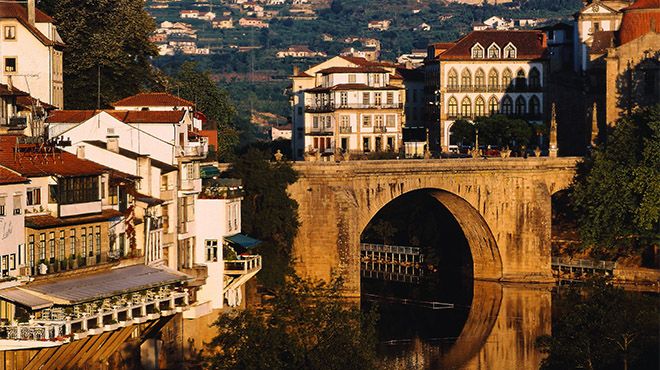Amarante

Towns and Villages
All visitors to Amarante will most certainly be impressed by two imposing natural features: the great Serra do Marão rising above the city in a series of majestic landscapes and the river Tâmega, the longest tributary of the river Douro, whose journey begins in Galicia and which flows through the heart of Amarante, giving added colour to the picturesque houses standing on its banks.
Some historians have attributed the foundation of this transitional city linking the provinces of Minho and Trás-os-Montes to a Roman centurion by the name of Amarantus. In the thirteenth century, St Gonçalo, a Benedictine monk and popular saint, arrived in this area, where he eventually settled after completing a pilgrimage to Italy and Jerusalem, later becoming the city´s patron saint. He is accredited with the building of a sturdy bridge over the Tâmega on the same site as the current one.
The bridge at Amarante perpetuates the memory of the local population´s heroic resistance against Napoleon's troops, who invaded Portugal in the early nineteenth century. In view of its position as a major gateway to the region of Trás-os-Montes, the city was besieged by Marshal Soult, although he met with stiff opposition from the local inhabitants, who bravely withstood his fierce attacks for a fortnight, until finally surrendering when the French bombarded them with barrels of gunpowder.
Amarante's sweets and cakes are extremely famous and easy to find in many of the region's cake-shops and cafés. Remember some of the names and make sure to taste them for yourself: papos de anjo, brisas do Tâmega, toucinho do céu, bolos de São Gonçalo, galhofas.
At the first Saturday of June takes place the Feast in honour of the Saint Gonçalo, much sought after by old spinsters in search of a husband.
No visitor to the region can afford to miss visiting the Serra do Marão in order to admire its breathtaking landscape. Roughly 20 kilometres away along the A4, travellers will find restful accommodation at the Pousada de S. Gonçalo, which has one of the most beautiful views in the whole of Portugal. Close by is the delightful valley of Ansiães, where you can visit the trout farms on the right bank of the river Ovelha, providing you with an excellent pretext for enjoying a walk through the dense woods that surround them.
The village of Travanca do Monte, which is reached by the road leading to Peso da Régua, is an extremely picturesque spot, offering a magnificent panoramic view of the whole region. On fine days, you can see the mountains of Marão, Gerês and Cabreira. In the village itself, your attention is drawn to the Casa da Levada, belonging to the family of the writer Teixeira de Pascoais. In the courtyard, notice the two enormous granite espigueiros (granaries used for drying and storing corn). At Chão de Parada, one can see a well-preserved dolmen.




 Explore
Explore 
 Remember and Share
Remember and Share 


